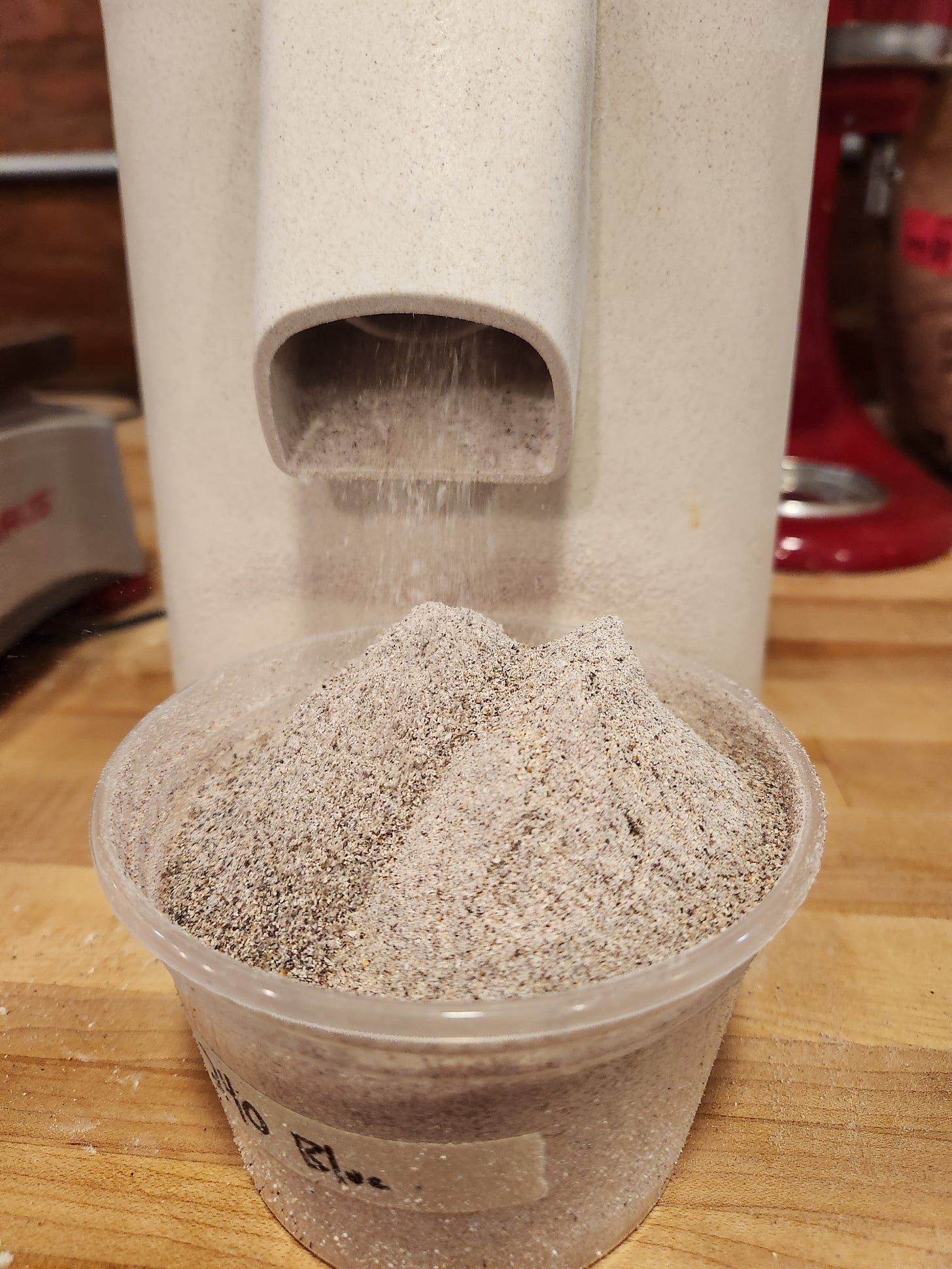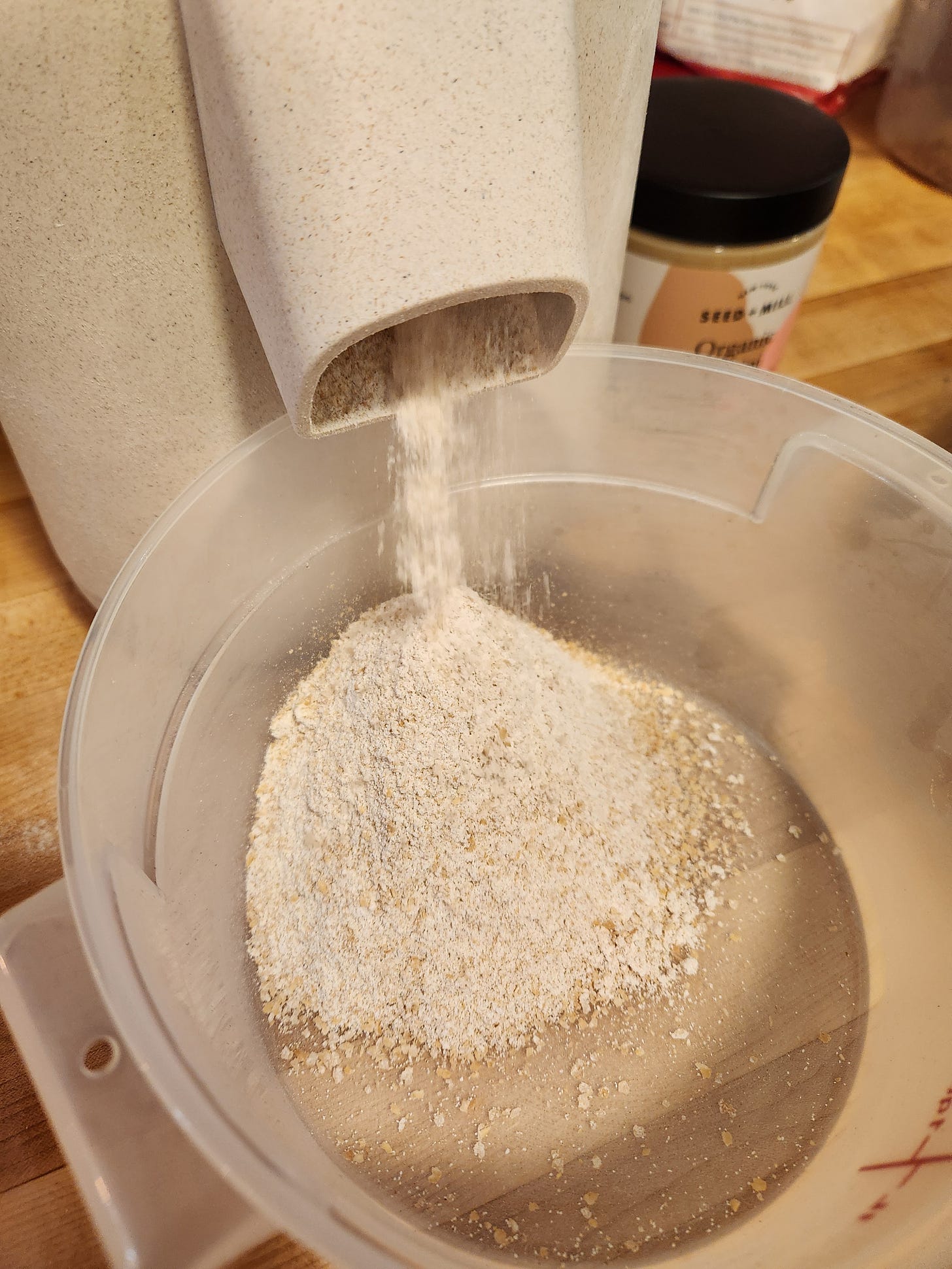Milling your own flour is easy. But like all parts of baking, it might not be something you feel compelled to do, and that’s ok! There are plenty of ways to get your hands on high-quality flour beyond milling it yourself. Last week we discussed why stone milled flour is usually a safe bet, and we’ll cover similar topics in the coming weeks.
But if you are interested in learning how to mill your own flour, this blog post is for you. And even if you don’t plan to mill your own flour, or at least not anytime soon, this blog post will still provide you with a valuable understanding of what happens behind the scenes.
Why Mill Your Own?
Milling your own flour is the easiest and most certain way to ensure your flour is the highest quality. If you buy whole wheat berries from a trusted farmer and mill them into flour which you then bake with, you’re present for every step of the process.
A good analogy would be buying some carrots and a chicken from a local farm and making some chicken soup. You can tell from the carrots, still covered in dirt and with bright green leafy tops, that they were harvested that morning. And from the other chickens running around and catching bugs, you can tell that the poultry in your bag came from a happy, healthy animal.
Compare that to buying a can of chicken soup in the grocery store. Sure, the packaging is attractive, but what can you really know about the quality of the ingredients in that soup? Were the carrots fresh and the chicken healthy? Equally important, were the famers who grew the carrots and raised the chickens paid fairly and empowered to run their farms according to their values?
Now, on days where I stay late at work, have a miserable commute home, and walk in the door to a pile of dirty laundry, I don’t feel like making chicken soup from scratch. I’m sure you can relate. In everything, there are times when convenience wins. Last week we talked about why roller milling grew in popularity in the 1940s, and many of the reasons were due to the simple fact that the homogenized, pure white flour roller milling produced was just more convenient for home cooks.
There is a time and place for convenience. But the good news is that milling your own flour doesn’t have to be all or nothing. Many home cooks get around weeknight soup dilemmas by making big pots on the weekends, meal prepping, canning, freezing, and so on. Similarly, flour milling makes a great weekend project, and even if you mill your flour a few days before you’ll need it, it will still be fresher than anything else on the market.
How Will the Flour I Mill Be Different?
The flour you mill yourself will be full-inclusion. To understand what that means, let’s talk about extraction.
Extraction is a technical term referring to how much bran is still present after sifting. For example, if flour is described as seventy percent extraction, thirty percent of the original weight of the flour was removed through sifting. That thirty percent was, of course, almost entirely bran.
In stone milled flour, the bran is broken up into particles of many different sizes. The big pieces are easy to sift out, but the smaller pieces tend to go through the sieve along with the endosperm. Since many factors, such as wheat berry hardness and milling temperature, affect what size pieces the bran breaks into, it can be difficult to know how much has fallen through the sieve. Describing flour by extraction quantifies how much bran has been removed by weight, and this data is vital in communicating to a baker how the flour will perform.
Inclusion is the opposite of extraction. Flour that has not been sieved at all is called full-inclusion flour. Another way of saying this would be “one hundred percent extraction,” although this is a bit of an oxymoron. More common in Europe are the terms “whole-grain” and “whole-meal,” which sometimes are accurate and sometimes are misused, just like “whole-wheat” is misused in the United States.
What Equipment Do I Need?
You will need a tabletop stone mill! The brand we use and love is Mockmill, but there are many different brands out there that do an excellent job. A tabletop stone mill is similar to a stand-mixer in size and price. And, like stand-mixers, you’re getting a compact machine that essentially has one function: it creates movement which processes your ingredients.
In addition to flour, tabletop stone mills can grind dried corn into cornmeal, buckwheat into buckwheat flour, and rice into rice flour. Some people use tabletop stone mills to grind seeds or spices, but we stay away from things that are too oily or that might leave residual flavors on the mill stones. Different manufacturers will have their own recommendations for what you can and can’t mill based on the specifics of each machine. Just remember, the stones are really not meant to be taken apart for cleaning that often, so in general, only mill things that will willingly fall out on their own.
Manufacturers usually have a line of mills ranging from basic models to more complex and expensive ones. The good news is that what you’re really paying for is two stones and an engine that spins one of them. If you stick with a trusted brand, even the most basic mill will serve you well for many years. More expensive mills do boast advantages, such as faster milling and better temperature control. The friction of the mill stones does generate heat, and too much heat can damage the flour. These advantages might be worth it to you if you plan to mill large quantities of flour at a time. But for basic home use, they are absolutely not required.
As an alternative to a tabletop stone mill, and at an even lower price point, milling attachments for your KitchenAid stand mixer can be great solutions for milling very small amounts of flour. As with any mill that you investigate, just be sure that it’s a stone mill.
So, if you’re ready to give home milling a shot, now is your moment! You’ll most likely need to order your flour mill online, as not many stores in the United States stock them. Be aware that it’s not uncommon for these machines to be backordered.
In a later blog post, we’ll cover the steps for milling your own, plus lots of tips and tricks to get the highest quality flour possible out of your mill.
This week’s recipe is for simple Sesame Cookies. These are a favorite at our bakery for customers who want just a little something that’s not too sweet. At our bakery, we make them with Seed + Mill Tahini, which is a wonderful woman-owned brand. Their tahini is organic and incredibly rich in flavor, and it makes our cookies shine. Let’s get baking!






